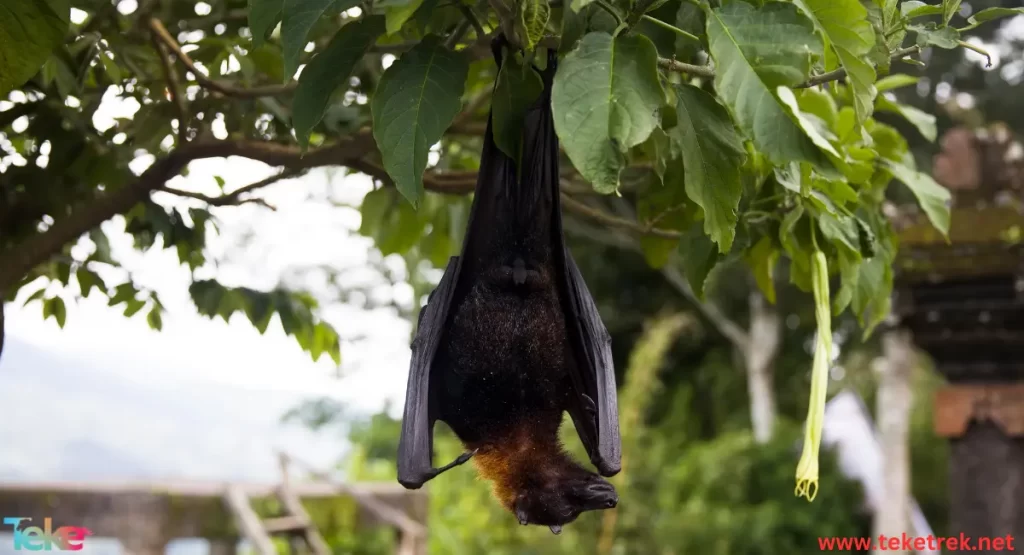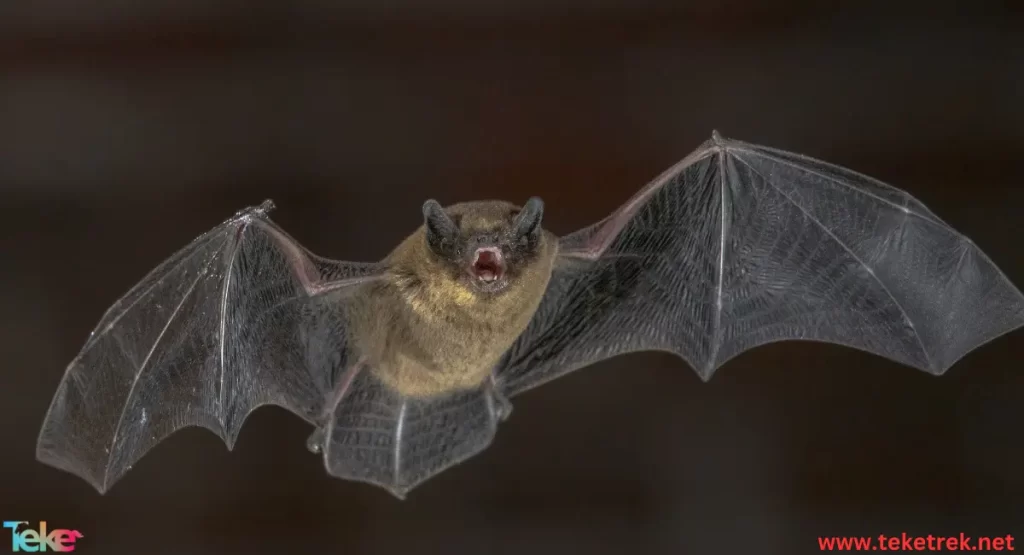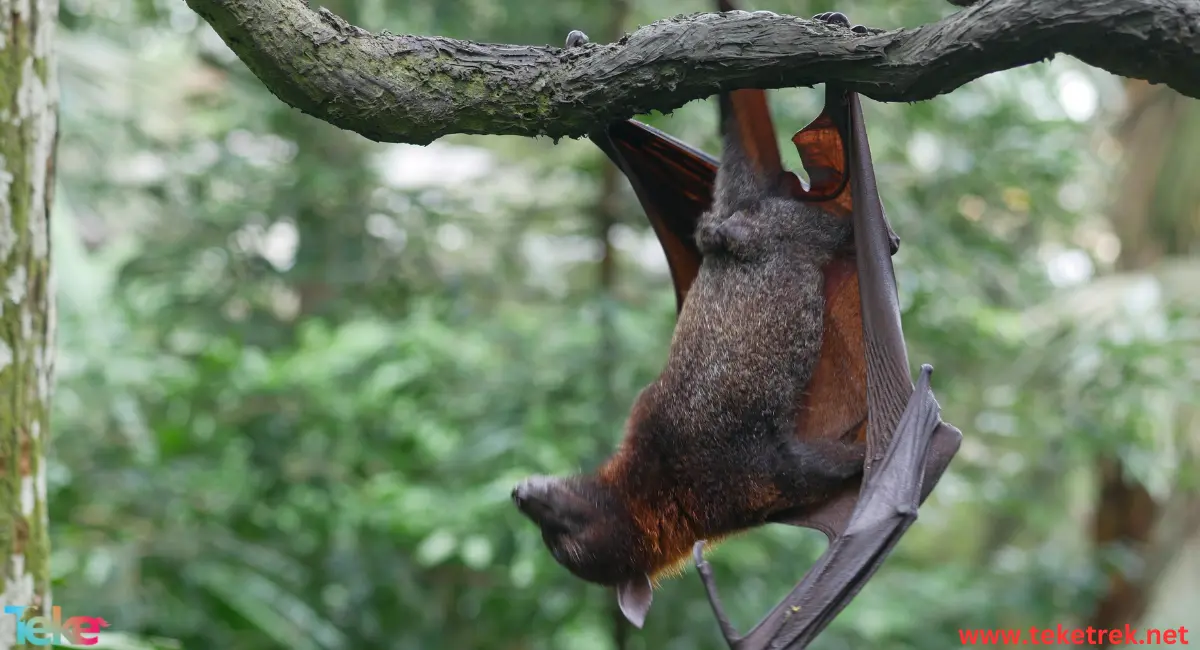The Egyptian fruit bat is one of the unique organisms that live in certain areas of Egypt, and it is considered an unusual species of bat that feeds mainly on fruits.
This organism is distinguished by its beauty and ecological importance in the flora and fauna system of the region.
The study of the Egyptian fruit bat is an interesting topic that deserves attention, as it contributes to the distribution of fruit seeds and the preservation of biodiversity in the environment. It is also considered an essential part of the ecosystem in the region, and plays a major role in the balance of nature, so we chose to talk about it in today’s article from Teke Trek.

About the Egyptian fruit bat
The Egyptian fruit bat, the Egyptian flying fox or the so-called Egyptian Rosetta (Rousettus aegyptiacus), is a species of Old World fruit bat that belongs to the large bat family (fruit bats) of the order Bats, phylum Chordata, class Mammalia.
Locations of the Egyptian fruit bat
The Egyptian fruit bat lives in specific areas of Egypt, in addition to some parts of the continent of Africa, with the exception of the Sahara Desert, Cyprus, Turkey, the Sultanate of Oman, as well as Yemen, eastern Pakistan, and northern India.
The Egyptian fruit bat is found mainly in desert and agricultural areas that contain fruit trees. The Egyptian fruit bat can be found in valleys, valleys, and small forests that contain sources of food and shelter.
In general, the Egyptian fruit bat tends to live in areas with a green environment and rich food resources, where it can easily find fruits to feed on.
These areas preserve the diversity of plants and animals that play an important role in providing food and shelter for the Egyptian fruit bat.
What is the diet of the Egyptian fruit bat?
The Egyptian fruit bat is a mammal with a vegetarian diet, as it feeds mainly on fruits such as oranges, mangoes, apples, grapes, dates, etc., in addition to fruits.
The Egyptian fruit bat can sometimes consume flower nectar and palm nectar.
This vegetarian diet is important, as it contributes to the spread of the seeds of the fruits it eats and thus to the spread of plants and trees in the environment.
Reproduction stages of the Egyptian fruit bat:
The Egyptian fruit bat reproduces through mating between a male and a female. This occurs in the spring when conditions are suitable for reproduction.
The Egyptian fruit bat has a complex social system, involving groups of males and females living together in caves or other places.
After mating, the female becomes pregnant for a period ranging between 3-4 months before giving birth to her young. The female gives birth to two young at each birth. She takes care of her young and feeds them with milk until they grow up and become able to fly and survive on their own.
The young continue to grow and develop until they are able to survive without help from the mother.
Egyptian fruit bat reproduction is an important part of their role in the environment and maintaining the balance of the ecosystem.
What are the characteristics of the Egyptian fruit bat
The Egyptian fruit bat is a small bat with a body length of up to 15 cm, and a wingspan of up to 60 cm.
The Egyptian fruit bat has a slender body and large wings that enable it to fly easily. It is also characterized by large ears and small eyes, and a skin color ranging from brown to dark brown with a black color on the back.
The Egyptian fruit bat has sharp teeth that it uses to cut the fruits and insects it feeds on.
The Egyptian fruit bat is characterized by its long, thin fingers, which help it pick up fruit and move between trees easily.
Although it is considered a nocturnal bat, it stays in dark places during the day and comes out to search for food at night.
What is the most important damage caused by the Egyptian fruit bat to the environment and humans?
The Egyptian fruit bat plays an important role in the environment as it is considered part of the biological transport system for insects and seeds, and it contributes to pollinating plants and dispersing fruit seeds. However, the Egyptian fruit bat can cause some of the following damage:
1. Disease transmission: Fruit bats can be carriers of many infectious diseases such as the emerging coronavirus (Covid-19), which can be transmitted to humans when handled unsafely.
2. Destruction of crops: In some cases, the fruit bat may feed on agricultural crops such as fruits and vegetables, which leads to the destruction of part of the crops.
3. Population disturbance: The presence of large numbers of fruit bats may cause disturbance to local residents, as a result of the noise they make or due to fears of disease transmission.
4. Compete with other animals: The fruit bat may compete with some other animals for food resources, affecting the ecological balance.
To control fruit bat damage, measures can be taken such as reducing direct contact with them, directing them to appropriate shelters, and applying effective and safe pest control techniques.

Frequently asked questions about the Egyptian fruit bat
What does the fruit bat eat?
The fruit bat feeds on the nectar of flowers and fruits.
How many types of bats are there in the world?
The number of bats in the world is about 1,200 species.
Are Egyptian fruit bats nocturnal؟
Yes, they are nocturnal.
Do Egyptian fruit bats live in caves?
Yes, they rest in trees, caves or ruins.
In short, the Egyptian fruit bat is an integral part of biodiversity, and plays a vital role in the ecosystem that is invaluable.
With the increasing challenges facing the environment and biodiversity in Egypt, researchers and environmentalists must study and protect the Egyptian fruit bat to maintain the balance of the ecosystem and ensure the continued existence of this wonderful creature in the country.
Collaborative work between researchers and the local community can ensure the continued existence of Egyptian fruit bats and preserve the beauty and richness of nature in this country.





